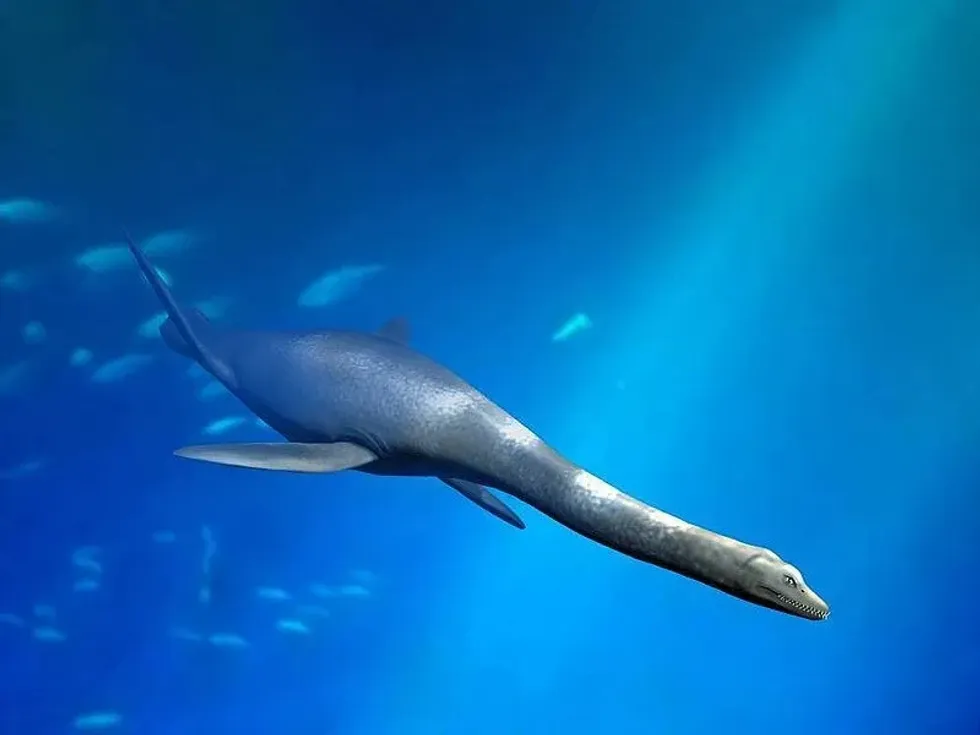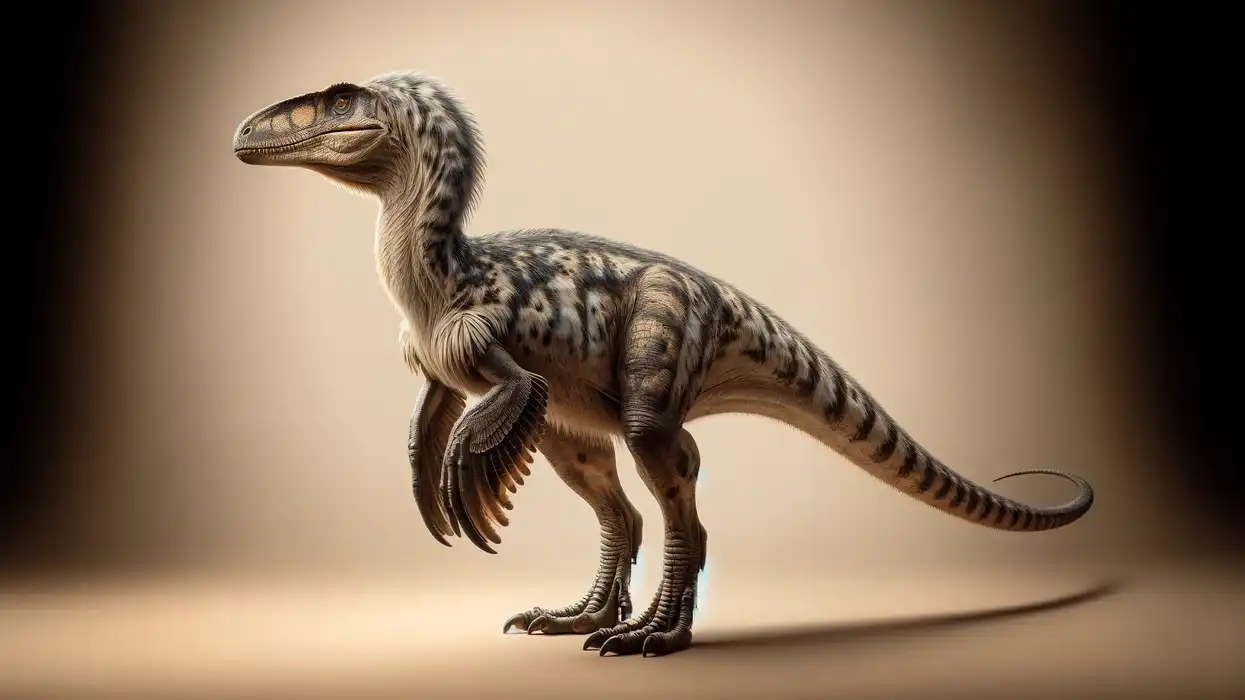The Kimmerosaurus were plesiosaur marine reptiles that were discovered on the sites of the Kimmeridge Clay Formation, Dorset, England. They looked like another species recovered from the same site, named Colymbosaurus. The first Kimmerosaurus fossil of a partial skull and neck vertebrae was found in the year 1981 by David S. Brown.
The search for the Kimmerosaurus fossils is still under review and the skull fossil is assumed by many scientists to be part of Colymbosaurus. The postcranial skeleton fossil of Colymbosaurus was found but lacked the head skull fossil.
The Kimmerosaurus was often confused by many viewers as being a dinosaur, but it was not a dinosaur and was a primitive marine reptile of the Jurassic period.
The name Kimmerosaurus was given to the species after the name of the site from where they were recovered, i.e., the Kimmeridge Clay Formation, Dorset, England. The later name 'saurus' means 'lizard'. They were known as the Kimmeridge lizards because they had slender bodies like those of lizard species.
If you enjoyed reading this article about the marine reptile plesiosaur from Kimmeridge clay, Dorset, England, then do read some interesting and surprising fun facts about other categories of marine animals such as Kaiwhekea and Cryptoclidus.
Kimmerosaurus Interesting Facts
Was the Kimmerosaurus a dinosaur?
No, the Kimmeridge lizard, Kimmerosaurus, was not a dinosaur and belonged to the class of reptiles. These species are often confused to be a dinosaur but they were the early primitive types of marine reptiles whose fossils are dated back to the English Upper Jurassic period.
How do you pronounce 'Kimmerosaurus'?
The word Kimmerosaurus is pronounced as 'Kim-mer-oh-sore-us'.
What type of marine reptile was a Kimmerosaurus?
The Kimmerosaurus was a marine reptile that lived during the Upper Jurassic period and belonged to the Reptilia class. They were from the order of Plesiosauria and the family of Crptoclididae.
The genus Kimmerosaurus's type species was Kimmerosaurus langhami. These marine reptiles are often confused as being dinosaurs, but their classification is done among reptiles according to their description.
The name Kimmerosaurus is named after the site location from where they have been recovered, Kimmeridge clay, Dorset, England, and the name 'saurus' means 'lizard' because they had a lizard-like body.
The category of the lizard-shaped body is a famous species from the English Upper Jurassic Period. The two genera, Colymbosaurus and Kimmerosaurus, were believed to share their habitat and are assumed to be the same plesiosaur, which can only be confirmed on the basis of a complete specimen discovery from the site of their location.
In which geological period did the Kimmerosaurus live?
The Kimmerosaurus roamed the earth during the English Upper Jurassic period, i.e., during the Kimmeridgian age, 145 million years ago.
When did the Kimmerosaurus become extinct?
The Kimmerosaurus became extinct by the end of the Upper Jurassic period.
Where did a Kimmerosaurus live?
The Kimmerosaurus lived in the Kimmeridge Clay Formation, Dorset, England. The first Kimmerosaurus fossils were discovered in the year 1981 by David S. Brown. This site location is now the Jurassic Coast and a World Heritage Site in the southern United Kingdom.
What was a Kimmerosaurus's habitat?
The Kimmerosaurus lived in the deep, shallow sea and swam in the open water of the Kimmeridge Clay Formation. The species did not live in the coral reef or lagoon and could have been had groups to protect their young from predators. They were acquainted with living near the sea bed of the shallow rivers and lakes.
Who did a Kimmerosaurus live with?
The Kimmerosaurus were believed to live in groups, but the exact number of their groups or school is unknown. As they lived in the open sea, they must have preferred to stay in groups to protect young ones from predators.
How long did a Kimmerosaurus live?
As per the specimens of Kimmerosaurus, they were dated back to the English Upper Jurassic period and must have lived 145 million years ago during the Kimmeridge age. The first Kimmerosaurus fossils were discovered in the year 1981.
How did they reproduce?
There is not much description given about the reproduction of these species in the order of plesiosaur. They were viviparous and gave birth to their offspring in the open sea.
It is assumed by many that they must have kept their new infants in the sanctuaries, but no strong evidence is available in this regard. The male must have fought with the other male in order to mate with the female species.
Kimmerosaurus Fun Facts
What did a Kimmerosaurus look like?
 We've been unable to source an image of Kimmerosaurus and have used an image of Plesiosaurus instead. If you are able to provide us with a royalty-free image of Kimmerosaurus, we would be happy to credit you. Please contact us at hello@kidadl.com.
We've been unable to source an image of Kimmerosaurus and have used an image of Plesiosaurus instead. If you are able to provide us with a royalty-free image of Kimmerosaurus, we would be happy to credit you. Please contact us at hello@kidadl.com. The Kimmerosaurus of the Kimmeridgian age was the least known marine reptile from the Kimmeridge Clay Formation because fewer fossils were discovered at the site, such as only a partial skull and neck cervical vertebrae were discovered.
The description of these species was very much different from a plesiosaur in regard to their teeth, jaws, and lack of longitudinal ridges, which were present in the fossils of a plesiosaur. These species' cervical vertebrae fossils resembled those of the Colymbosaurus postcranial skeleton.
They had a slender body with a long neck almost equal to their body size, and four limbs that looked like their fins, which helped them to swim fast in the open water.
The search for the fossils is still in progress from the site location of the marine animal. It is also assumed that the missing fossil of a Colymbosaurus head could be the Kimmerosaurus fossils discovered.
However, strong evidence is required to support this theory.
How many bones did a Kimmerosaurus have?
The exact number of bones of the Kimmeridgian age marine reptile, Kimmerosaurus, is not estimated and is unknown to the world. Two specimens of these genus species were recovered: the partial skull and the cervical vertebrae.
The type specimen discovered was NHMUK R.8431, a fossil of a partial or incomplete head skull. The first Kimmerosaurus, a plesiosaur fossil, was discovered in 1981.
How did they communicate?
The Kimmerosaurus communication is evaluated and is unknown to the world. However, generally, the plesiosaur was believed to communicate using tactile cues, vocals, and sound waves. They even used chemical cues to sense danger around them.
How big was a Kimmerosaurus?
According to the description of this plesiosaur, Kimmerosaurus was 19.5 ft (5.94 m) long in length. To be specific about the Kimmerosaurus neck length, it was 5 ft (1.5 m) which is known from the Kimmerosaurus fossils of cervical vertebrae.
How fast could a Kimmerosaurus move?
The Kimmerosaurus, a plesiosaur, could move at 3 mph (10 kph). This speed is almost faster than a shark's speed and a little less than a Pliosaurus.
How much did a Kimmerosaurus weigh?
From the Kimmerosaurus fossils, their weight is estimated to be around 1.1 ton (1000 kg). This weight could slightly differ or vary depending upon the Kimmerosaurus' size.
What were the male and female names of the species?
There was no specific name given to the male and female species of Kimmerosaurus. They were known by their generic names, the male Kimmerosaurus and the female Kimmerosaurus.
What would you call a baby Kimmerosaurus?
The babies of Kimmerosaurus were called hatchlings, infants, and juveniles.
What did they eat?
The classification of Kimmerosaurus was done among the carnivore marine reptile species. The teeth of these species did not look like the teeth of a plesiosaur with shrunk cheeks on their tongue side inward.
These species had eight premaxilla teeth and 36 dentary teeth on each ramus, making them a deadly predator for the sea animals around them. The teeth were very sharp and curved to tear apart the flesh into pieces. They preyed on marine animals such as small fishes, sharks, Squatina, and turtles.
How aggressive were they?
Though there is not much known about the behavior of these marine reptiles from the Jurassic period, they could have been aggressive on the basis of their food habits and fossils like the genus of plesiosaur. They could have been in competition with other Colymbosaurus known for their postcranial skeleton.
These two genera, Kimmerosaurus and Colymbosaurus, would have been in fights over the protection of infants and food. Another rival of Kimmerosaurus would have been Pliosaurus dominating the long neck genus Kimmerosaurus.
Did you know...
The Kimmerosaurus was broadcast in the BBC channel documentary Planet Dinosaur with the Pliosaurus. An exact idea of what these reptiles from the Jurassic period looked like can be seen in Planet Dinosaur.
Who discovered Kimmerosaurus?
The Kimmerosaurus was discovered by the paleontologist, David S. Brown, in 1981.
Did Kimmerosaurus breathe air?
The Kimmerosaurus lived in the deep, shallow seas to prey on marine animals. As these were reptiles, they had to come to the surface of the seawater to breathe air for a certain period of time.
Here at Kidadl, we have carefully created lots of interesting family-friendly prehistoric animal facts for everyone to discover! Learn more about some other creatures from our Plesiopleurodon fun facts, or Macroplata facts for kids.
You can even occupy yourself at home by coloring in one of our free printable Kimmerosaurus coloring pages.










